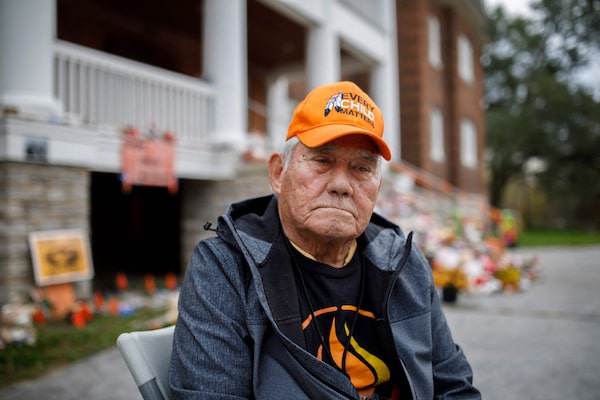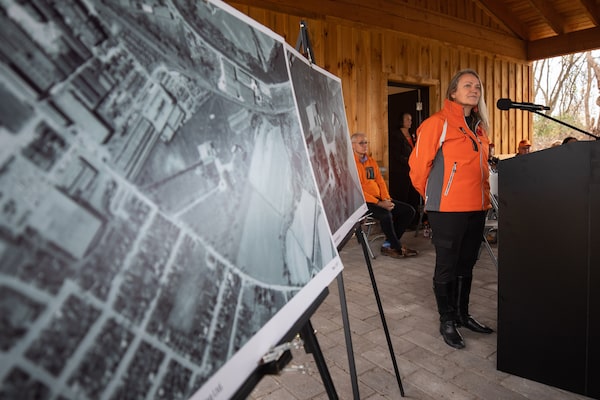Members of the Six Nations Police conduct a search for unmarked graves using ground-penetrating radar on the 500 acres of the lands associated with the former Indian Residential School, the Mohawk Institute, in Brantford, Ont., on Nov. 9.Nick Iwanyshyn/The Canadian Press
An Ontario First Nation began searching the grounds of a former residential school Tuesday, looking for unmarked graves in what some survivors called a difficult but necessary step toward healing.
The search in Brantford, Ont., will cover about 200 hectares surrounding the Mohawk Institute, located near the territory of the Six Nations of the Grand River.
Chief Mark B. Hill of the First Nation said his community is finally ready to begin investigating the grounds of the former residential school.
“For many, this day has been long awaited, but also brings with it a stark reminder of the atrocities that were committed against our people in these institutions,” he said.
He said his community members are getting ready for the potential findings of the search.
“The scope and depth of this investigation is unique … it’s very unchartered territory,” Mr. Hill said.
“The months ahead will be difficult, but this work will allow our community to begin the process of healing together.”
Two ground penetrating radar machines are being used to conduct grid searches around the school. Members of the First Nation and its police service members have been trained on using the radar machines and will work together to conduct the search.
A few of the former residential school’s survivors attended the first day of the ground search.
John R. Elliott, of the Six Nations of the Grand River, said he attended the school between 1947 and 1952.
The 84-year-old man said he escaped many times from the school during that period of time but he was always being forced to go back.
“I would run away a lot ... between 25 and 30 times,” Mr. Elliott said.

John Elliott, 85, a survivor of the Mohawk Institute Residential School, at the grounds of the former school in Brantford on Nov. 9.COLE BURSTON/AFP/Getty Images
“[I was] 10 and in Grade 3 and when I left five years later, I was 15 and in Grade 5.”
The search is a step in the right direction to bring conclusion to the survivors and the families so they can start healing, he said.
“It just took them a long time to get started but finally they started, which is great to see,” Mr. Elliott said.
The executive lead of the Survivors’ Secretariat of the Six Nations of the Grand River said the first phase of the search will focus on the lands where the school building stands.
Kimberly R. Murray said the survivors know the truth of what actually happened on the grounds of the Mohawk Institute.
Modern technology and machines can help in uncovering the truth, but they won’t replace the first-hand knowledge of the survivors, she said.
“Those who were here and are here with us today, they are our witnesses,” Ms. Murray said.
“They are the ones that know what these lands looks like decades ago, and where the many different structures are located.”
This week the search will focus on areas surrounding the building, then expand to the rest of the 200 hectares in the spring, Ms. Murray said. Data will be uploaded onto secure servers and will then be sent for expert analysis.

Kimberly R. Murray, Executive Lead of the Survivors’ Secretariat, on Nov. 9.Nick Iwanyshyn/The Canadian Press
Once a final report is ready, Ms. Murray said the findings will be released to the community and survivors, then the general public.
Ms. Murray said First Nations communities should take ownership of the residential schools’ records, because they can analyze and assess the records more quickly and accurately.
“They do not need, nor have they asked, for the government to review records on their behalf. The time has come for institutions to turn over all the records to communities now,” she said.
The Mohawk Institute was one of the oldest and longest running residential schools in Canada, established in 1831 and closed in 1970.
In May, a First Nation in Kamloops announced that ground-penetrating radar had detected what are believed to be the remains of 215 Indigenous children in unmarked graves at the site of a former residential school.
Cowessess First Nation in Saskatchewan revealed a similar finding of more than 700 unmarked graves a month later.
Ontario’s Progressive Conservatives government recently announced a $10-million top-up to an initial $10-million it pledged in June for investigations into unmarked graves in that province.
The expert who used ground-penetrating radar at the former Kamloops Indian Residential School says there are likely more unmarked graves in the area with less than two acres of the 160-acre site surveyed. Sarah Beaulieu of the University of the Fraser Valley spoke at a news conference where the Tk’emlúps te Secwépemc First Nation also called for the release of attendance records from the school.
The Globe and Mail
Our Morning Update and Evening Update newsletters are written by Globe editors, giving you a concise summary of the day’s most important headlines. Sign up today.